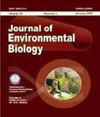比较分析:沙特阿拉伯传统草药和硼酸对登革热病媒埃及伊蚊幼虫的杀幼虫功效
IF 0.7
Q4 ENVIRONMENTAL SCIENCES
引用次数: 0
摘要
目的:本研究评估了沙特阿拉伯传统草药与硼酸相比对埃及伊蚊幼虫阶段的杀幼虫特性。研究方法:以埃及伊蚊幼虫的第 3 和第 4 幼虫阶段为对象,对 8 种植物提取物和硼酸的杀幼虫活性进行了评估。通过立体解剖显微镜,记录了用硼酸处理的幼虫的形态和死亡缺陷。结果显示结果表明,在 30% 的浓度下,死亡率从 59.3% 到 98.3% 不等。特别值得注意的是硼酸、洋甘菊和泽兰属植物的死亡率为 100%至 89%,属于高效类。小豆蔻、阿拉伯小豆蔻和甜叶菊表现出中等效果(88% 到 70%),而中华小豆蔻、黑小豆蔻和巴拉圭小豆蔻的效果相对较低(50% 到 69%)。值得注意的是,硼酸显示出显著的效力,即使在 1 ppm 的极低浓度下,也能诱导 28.3% 的死亡率,并对处理过的幼虫产生明显的畸形影响。这些发现强调了硼酸无与伦比的杀幼虫剂能力,使其成为综合蚊虫控制战略的首选。解释:此外,硼酸的可获得性、成本效益以及对生态系统和人类健康的最小影响使其成为减少埃及蚁数量的一个令人信服的解决方案,从而强化了我们防治蚊媒疾病的武器库。关键词:埃及伊蚊埃及伊蚊 生物防治 硼酸 植物提取物本文章由计算机程序翻译,如有差异,请以英文原文为准。
Comparative Analysis: Larvicidal efficacy of traditional Saudi Arabian herbs and boric acid against Aedes aegypti larvae, the Dengue fever vector
Aim: This study evaluates the larvicidal properties of traditional Saudi Arabian herbs compared to Boric acid against the Aedes aegypti larval stage. Methodology: An evaluation of the larvicidal activity of eight plant extracts, as well as Boric acid, was conducted with Ae. aegypti larvae in the 3rd and 4th larval stages. Through stereo-dissecting microscope, morphological and death defects in larvae treated with Boric acid were documented. Results: The results showed that the mortality rates ranged from 59.3 to 98.3% at 30% concentration. Particularly noteworthy were Boric acid, M. chamomilla, and C. zeylanicum, demonstrating mortality rates of 100 to 89%, falling within the highly effective category. E. cardamomum, C. arabica, and A. sativum exhibited moderate efficacy (88 to 70%) whereas C. sinensis, P. nigrum and I. paraguariensis manifested relatively lower effectiveness (50 to 69%). Significantly, Boric acid showcased remarkable potency, inducing mortality rates of 28.3% even at an infinitesimal concentration of 1 ppm, accompanied by distinct malformation effects on treated larvae. These findings underscore the unparalleled larvicidal prowess of Boric acid, positioning it as a paramount choice for integrated mosquito control strategies. Interpretation: Furthermore, Boric acid accessibility, cost-effectiveness, and minimal impact on ecological systems and human health make it a compelling solution for mitigating Ae. aegypti populations, thereby fortifying our arsenal against mosquito-borne diseases. Key words: Aedes aegypti, Biological control, Boric acid, Plant extract
求助全文
通过发布文献求助,成功后即可免费获取论文全文。
去求助
来源期刊

Journal of environmental biology
ENVIRONMENTAL SCIENCES-
CiteScore
1.70
自引率
0.00%
发文量
92
审稿时长
3 months
期刊介绍:
Information not localized
 求助内容:
求助内容: 应助结果提醒方式:
应助结果提醒方式:


